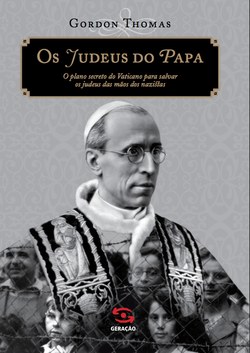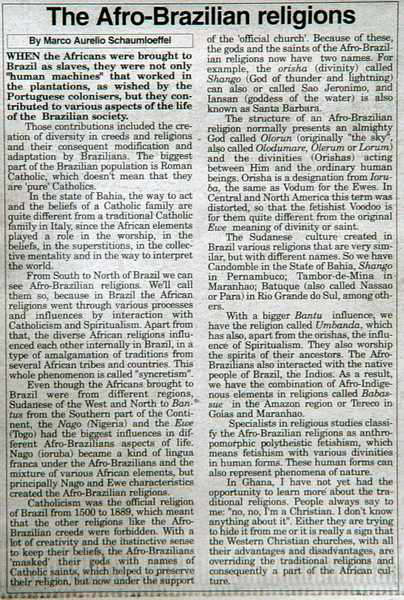SCHAUMLOEFFEL, Marco Aurelio. The Afro-Brazilian religions. Daily Graphic, Accra, v. 149159, p. 9 – 9, 15 jun. 2004.
The Afro-Brazilian Religions
When the Africans were brought to Brazil as slaves, they were not only “human machines” that worked in the plantations, as maybe wished by the Portuguese colonizers, but fortunately they contributed in various aspects of the life of Brazilian society. Under those contributions are the creation of diversity in creeds and religions and the consequent modification and adaptation of them in Brazil. The biggest part of the Brazilian population is Roman Catholic, which doesn’t mean that they are “pure” Catholics. In the state of Bahia the way to act and to belief of a Catholic family is certainly quite different from a traditional Catholic family in Italy, since the African elements played a role in the worship, in the beliefs, in the superstitions, in the collective mentality and in the way to interpret the world.
From South to North of our country we can see Afro-Brazilian religions. Well call them so, because in Brazil the African religions suffered various processes of influences and interaction with Catholicism and Spiritualism. Apart from that, the diverse African religions influenced each other internally in Brazil, in a type of amalgamation of traditions from several African tribes and countries. This whole phenomenon we call “syncretism”.
Even though the Africans brought to Brazil were from different regions, from Sudanese people of the West and North to Bantu people from the Southern part of the Continent, the Nago (Nigeria) and the Ewe (Togo) had the biggest influences in different Afro-Brazilians aspects of life. Nago (ioruba) became a kind of lingua franca under the Afro-Brazilians and the mixture of various African elements, but principally Nago and Ewe characteristics, created the Afro-Brazilian religions. Catholicism was the official religion of Brazil from 1500 to 1889, which meant, that the other religions like Afro-Brazilian creeds were forbidden. With a lot of creativity and the instinctive sense to keep their beliefs, the Afro-Brazilians “masked” their Gods with names of Catholic saints, which helped to preserve their religion, but now under the support of the “official church”. Because of these, the Gods and the saints of the Afro-Brazilian religions normally have nowadays two names. So e. g. the orisha (divinity) called Shango (God of thunder and lightning) can be also called Sao Jeronimo and Iansan (Goddess of the water) is also known as Santa Barbara.
The structure of an Afro-Brazilian religion normally presents an almighty God called Olorun (originally “the sky”, also called Olodumare, Olerum or Lorum) and the divinities (Orishas) acting between Him and the ordinary human beings. Orisha is a designation from Ioruba, the same as Vodum for the Ewes. In Central and North America this term was distorted, so that the fetishist Voodoo is for them quite different from the original Ewe meaning of divinity or saint.
The Sudanese (people from West Africa) culture created in Brazil various religions that are very similar, but labelled with different names. So we have Candomble in the State of Bahia, Shango in Pernambuco. Tambor-de-Mina in Maranhao, Batuque (also called Nassao or Para) in Rio Grande do Sul, amongst others. With a bigger Bantu influence, we have the religion called Umbanda, which has also, apart from the orishas, the influence of Spiritualism. They also worship the spirits of their ancestors. The Afro-Brazilians also interacted with the native people of Brazil, the Indios. As a result, we have the combination of Afro-Indigenous elements in religions called Babassue in the Amazon region or Tereco in Goias and Maranhao. Specialists in religious studies classify the Afro-Brazilian religions as anthropomorphic polytheistic fetishism, which means fetishism with various divinities in human forms. These human forms can also represent phenomena of nature.
The Afro-Brazilian religions are less closed than the Juju is in Ghana or in Nigeria; sacrifices to pay for good gods or to avoid malevolence are however done in secret in both places. In spite of the former syncretism, the Afro-Brazilian religions form separate churches, even if the same people attend more than one type of worship in the same day.
In Ghana I didn’t have the opportunity as yet to learn more about the traditional religions. People always say to me: “no, no, I’m a Christian. I don’t know anything about it”. Either they are trying to hide it from me or it is really a sign that the Western Christian churches, with all their advantages and disadvantages, are overriding the traditional religions and consequently a part of the African culture.
Marco Aurelio Schaumloeffel
Brazilian Lecturer in Ghana


